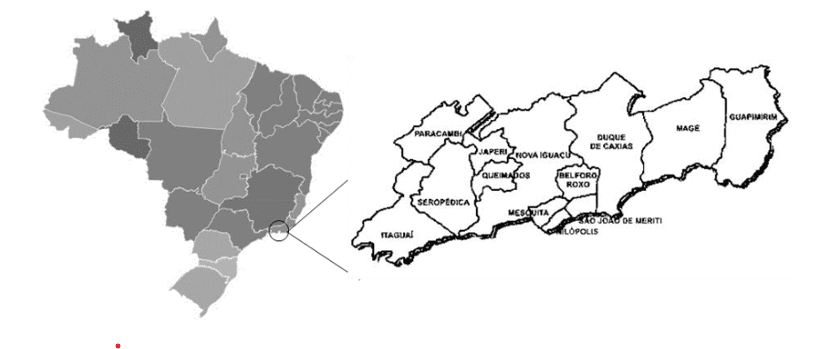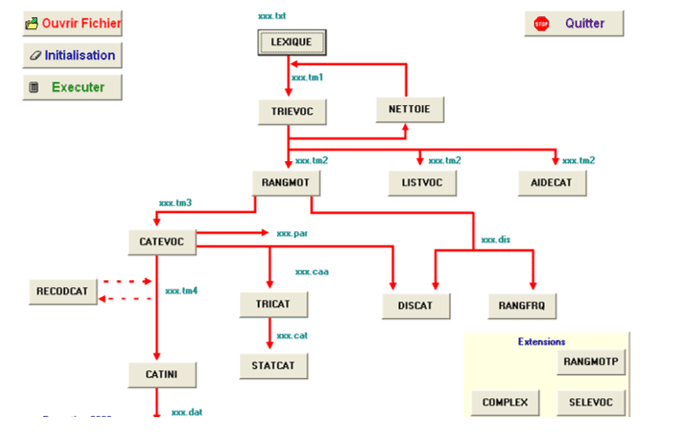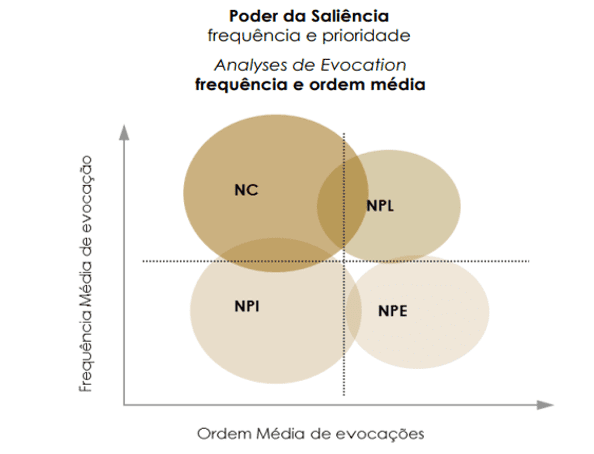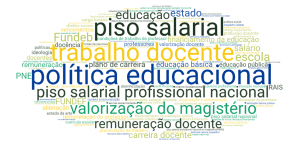ORIGINAL ARTICLE
MACEDO, Davinni da Silva [1], GONZAGA, Luciano Luz [2]
MACEDO, Davinni da Silva. GONZAGA, Luciano Luz. Prototypical analysis of regular class teachers about the resource room. Revista Científica Multidisciplinar Núcleo do Conhecimento. Year. 08, Ed. 04, Vol. 03, pp. 42-53. April 2023. ISSN: 2448-0959, Access link: https://www.nucleodoconhecimento.com.br/education/prototypical-analysis, DOI: 10.32749/nucleodoconhecimento.com.br/education/prototypical-analysis
ABSTRACT
This research is an integral part of the Professional Master’s Degree in Science and Health Teaching, of a Higher Education Institution in the State of Rio de Janeiro, and aims to identify the main cognems of Basic Education teachers, of a public school in the Baixada Fluminense region, in the State of Rio de Janeiro, about the Multifunctional Resource Room. To the group, a Test of Free Evocation of Words was applied from the inducing term “resource room” and the analysis was performed by the Evocation 2000 software. Moscovici’s Theory of Social Representations (1961) was the main theoretical contribution of the research. In this way, we sought to detect possible beliefs that regular class teachers develop about the resource room of the school unit where they work in an attempt to value the knowledge and opinions of these professionals in relation to Specialized Educational Assistance (AEE)[3] and to think of possible strategies that can contribute to collaborative work between regular class teachers and resource room teachers. As a result, the centrality of representation reveals that ‘love’ is the gear for the space to function. On the other hand, the periphery reveals the character of help and zeal in assisting students with special needs.
Keywords: Social Representations, Multifunctional Resource Room, Special Education.
INTRODUCTION
The history of education is marked by practices of exclusion or neglect of students with special needs, sometimes due to lack of knowledge, sometimes for considering a standard student body as a reference. However, the years have changed and the school needed, and still needs, to adapt to modern times, in which it is no longer possible to exclude. In this regard, the current school needed and needs to respond to the demands of the population and, among the actions, the creation of the multifunctional resource room emerges to support the premises of school inclusion (MENESES et al., 2020; MATSUKURA; LINS; SQUASSONI, 2021).
The resource room, according to the Ministry of Education, is a space, of a pedagogical nature, intended for the service of “students who have similar special educational needs, at a different time from that in which they attend the regular class. […]” (BRASIL, 2001, p. 50). Its main mission is to assist the process of “schooling, eliminating barriers that [prevent] the full participation of students target audience of special education, with autonomy and independence, in the educational and social environment” (BRASIL, 2018, p. 6).
It is important to inform that, still in terms of legislation, a very important milestone for the direction of Special Education in our country occurred with the Magna Carta (1988), which lists, in Article 208, the obligation of specialized educational assistance to people with disabilities, preferably in the regular education network (BRASIL, 1988).
Therefore, special education is a proposal that must be assumed and guaranteed throughout the national territory, with the presence of all children in regular schools through Specialized Educational Assistance (AEE) (POSSA; PIECZKOWSKI, 2020).
With regard to the performance of teachers in special education, Oliveira and Prieto (2020) warn us about an adequate pedagogical proposal for special education in initial and continuing training courses, as well as an evaluation and monitoring system regarding the structure and to the organization of the space used in the AEE.
Resolution CD/FNDE/MEC nº 15, of October 7, 2020 (BRASIL, 2020), about the implementation of multifunctional spaces in public schools, deals with accessibility, the effective participation of students with disabilities, the participation of family in the teaching and learning process. However, how does it work in practice? What is the representation that regular classroom teachers have of this space?
Reflecting on these concerns is why we decided, before developing the educational product of the master’s degree[4], to identify the possible beliefs of the teachers of the regular classes and, in this attempt, to propose joint and collaborative actions in the attendance of the student-target of special education. Since, one of the attributions of the teacher who works in the resource room is “to establish articulation with the teachers of the common classroom, aiming at the provision of services, pedagogical and accessibility resources and strategies that promote the participation of students in activities schools” (Art. 13 of Opinion nº 13/2009 of the CNE-CEB) (BRASIL, 2009).
In this regard, considering that this articulation is of fundamental importance, we are interested in knowing, a priori, which social representations that Elementary School I teachers, from regular classes, have about the space dedicated to Specialized Educational Assistance – AEE.
DEVELOPMENT
The school, the research locus, is located in the municipality of Magé, in the Baixada Fluminense region, 62 km from the capital of Rio de Janeiro (Figure 1). It works in two shifts (morning and afternoon) and serves the early years of elementary school.
Figure 1. Geographic location of the municipalities that make up the Baixada Fluminense Region, RJ

Until now, the School has 303 students enrolled, of which 25 (8.25%) are considered a target audience for Special Education, assisted after school hours by the Multifunctional Resource Room service.
The social group chosen for carrying out this research is composed of 10 Elementary School I teachers, with a mean age of 35.6 years (Pad Dev = 7.4) and an average teaching time of 10.8 years ( Pad Dev = 5.35), revealing to be a homogeneous group and that, therefore, it has already overcome the phase of discovery and survival of the beginning of the teaching career (HUBERMAN, 2000).
METHODOLOGICAL COURSE
The research approach is qualitative, consisting of a Word Free Association Test (TALP)[5] applied to a group of teachers from regular classes. This test allows the interviewee to speak and write words that come to mind, after being stimulated by a word or inducing expression that characterizes the object of study (SÁ, 2002).
Therefore, the TALP is based on a projective technique guided by the hypothesis that the subject’s psychological structure becomes palpable through the manifestations of conduct, evocations, choices and creations, constituting indices that reveal the personality as a whole (COUTINHO et al., 2001).
Thus, we asked the teachers of the regular classes to list the first five words that came to mind, related to the inducing term ‘resource room’, in a time of five minutes.
The promptly evoked responses were analyzed and treated by software entitled Evocation 2000® (VERGÈS; SCANO and JUNIQUE, 2002) developed in France by Pierre Vergès; Scano and Junique (2002) (Fig. 2). This software makes it possible to identify “the possible elements of the central nucleus through the frequency (F) with which the word was enunciated by the subjects and the average order of evocation (OME)[6]” (ALVES-MAZZOTTI, 2007, p. 299).
Figure 2- Initial screen of the Evocation 2000 software with the 16 programs

Among the 16 programs, only five were used in the development of this research, they are: LEXIQUE, whose function is to isolate the lexical units of the file; TRIEVOC, which screens evocations; NETTOIE, which eliminates possible typing errors; the RANGMOT, which provides the frequency and order of evocation and, finally, the RANGFRQ, which organizes the elements that will make up the Central Core and the peripheral system of the prototypical analysis in a four-box frame (GONZAGA, 2020).
Therefore, from the combination of the frequency and the average order of evocation of the words carried out by the software, we obtained their distribution in a diagram with two orthogonal axes, composing a table of four houses and that can be understood in Figure 3.
Figure 3- Diagram with the disposition of the Central and Peripheral Nuclei, according to the Frequency of Words (F) and the Average Order of Evocations (OME)
 In the figure: NC: Central Nucleus; NPL: Peripheral Boundary Nucleus; NPI: Intermediate Peripheral Core; NPE: Outer Peripheral Core. Source: Velloso (2009).
In the figure: NC: Central Nucleus; NPL: Peripheral Boundary Nucleus; NPI: Intermediate Peripheral Core; NPE: Outer Peripheral Core. Source: Velloso (2009).
The evocations that will compose the upper left quadrant (NC) will constitute the words that were most evoked and with high prevalence (cited in the first orders). According to Sá (2002), these evocations would have greater importance in the subjects’ cognitive scheme and, therefore, possible to represent the object of study.
Thus, we used Abric’s Central Nucleus Theory as a theoretical-methodological contribution to analyze the responses to the evocation tests. Abric (1998), explains that:
a organização de uma representação apresenta uma característica particular: não apenas os elementos da representação são hierarquizados, mas além disso toda representação é organizada em torno de um Núcleo Central, constituído de um ou de alguns elementos que dão à representação o seu significado (ABRIC, 1998, p. 28, grifos nossos).
The central nucleus is responsible for giving meaning and organization to the representation, being strongly linked to the group’s memory. The periphery, on the other hand, is connected to the daily life and experiences of individuals (ABRIC, 2000).
This theory also considers the existence of the so-called ‘peripheral system’, which shelters the differences in perception between the individuals involved in the research, supporting the heterogeneity of the group and accommodating the contradictions brought about by the more immediate context. Therefore, its basic function is to allow the adaptation to the concrete reality, allowing the differentiation of the content and protecting the Central Nucleus (SÁ, 1998).
RESULTS
In order to better understand the internal organization of the Social Representations (prototypical analysis), we asked the teachers of the regular classes, which have students assisted by the Specialized Educational Service (AEE), to list five words associated with the inducing term ‘Resource Room’ (Chart 1).
Table 1 – Analysis of the Central Nucleus to the inducing term ‘Resource Room’ among teachers of regular classes at the Municipal Department of Education, Magé, RJ

The Central Nucleus (upper left quadrant – Chart 1) seems to represent, by the regular class teachers, the ‘resource room’ as a ‘help’ space, a post that needs to promote the necessary ‘adaptation’ with ‘love’. In this context, the teachers seem to believe that the resource room functions as a support space and that, for this purpose, it needs to be adapted.
The ‘love’ as an essential element in this support offered to students assisted by the resource room calls our attention. Judith Perez (2017, p. 106), in her thesis about the social representations of teaching work with teachers in the early years of basic education, in the city of Rio de Janeiro, identifies the presence of a “discourse about teaching work that affirms the need to ‘apply’ or ‘have’ love for the profession, since the student deserves it, needs affection”.
Several studies will relate this ‘love’ to the process of feminization of teaching itself, that is, a feeling specific to the female gender that is put into practice in pedagogical activity (CAMPOS, 2008; SILVA; SCHERER; DAL’IGNA, 2019; VIEIRA, 2022).
With regard to adaptation, Silva (2022, p. 3) states that the school environment, being a wide and diverse space, should be able to adapt to individual needs and reiterates that the main purpose of building classrooms with multifunctional resources is to employ “various methodological resources and techniques capable of providing assistance to the target audience of special education so that they can develop indistinctly within regular education”.
In the upper quadrant to the right of Table 1, Peripheral Boundary Nucleus, the cognem ‘care’ appears and, because it was much mentioned, even late, it is possible that, by inference, it will become part of the Central Nucleus. In this regard, it seems that the teachers in this research see this space as a time to be considerate of others, to feel and experience the needs of others (HOLLANDA, 2011).
However, we agree with Matsukura; Lins; Squassoni (2021, p. 722), when they state that care for students assisted by the AEE should be constructed based on the principle of intersectoriality, that is, “intersectoral articulations between school professionals and those from other sectors, such as health and assistance Social”. Therefore, it is not exclusively the role of those who work in the multifunctional resource room.
In the lower left quadrant of Chart 1, Intermediate Peripheral Nucleus, we have the evocations that were cited as a priority, but with low frequency. This means that, for some teachers, ‘partnership’ and ‘respect’ are very important in the functioning of the space. In this sense, for this small group, there seems to be an understanding of the importance of the intersectionality mentioned above and that ‘respect’ can be associated with the understanding of the peculiarities and life history of each student (DANTAS; CORTÊS, 2016).
In the periphery itself (lower quadrant on the right – Chart 1), the pressures fortuitously imposed by the reality of the group are expressed. According to Flament (2001), the periphery of a social representation, precisely because of this characteristic of eventuality, “is considered a bumper between reality and a central nucleus that does not change easily” (emphasis added).
Faced with these representations, the resource room seems to function as a ‘support’ for students who need specialized care or ‘support’ for teachers of regular classes in the teaching and learning process. Such representations corroborate the guidelines of the Ministry of Education, which lists that the multifunctional resource room must be designed to offer the necessary support to students and teachers, with appropriate equipment, various teaching materials and professionals with adequate training for the service (BRASIL , 2007).
FINAL CONSIDERATIONS
This exploratory research brings us some important notes, namely: the Central Nucleus about the inducing term ‘resource room’, by teachers of regular classes, revealing a possible belief of a space where ‘love’ is the gear for functioning. This feeling is quite common in identity representations of ‘being a teacher’. On the other hand, the periphery reveals a shielding system in which it reinforces the helping character and zeal in assisting students with special needs.
Another high point of this research is the intersectoriality of the resource room envisioned only by a small group of teachers and which should be widely disseminated in teachers’ meetings, parents’ meetings and effectively appear in the Political Pedagogical Project of the schools.
The reflections carried out about the possible social representations made it possible to understand that there is an understanding of the research teachers in terms of space and specialized educational assistance. However, it is urgent to incorporate this space into the school culture and articulate it with sectors beyond the school wall.
REFERENCES
ABRIC, J.C. A construção do objeto de pesquisa em representações sociais. Rio de Janeiro: EdUERJ. 1998, 106 p.
ABRIC, J.C. A abordagem estrutural das representações sociais. In: MOREIRA, A. S.P.; OLIVEIRA. D.C (Org.). Estudos interdisciplinares de representação social. Goiânia: AB, 2000, p. 27-32.
AGÊNCIA DE NOTÍCIAS DAS FAVELAS. Baixada Fluminense, periferia do Estado. Agência de Notícias das Favelas, 2019. Disponível em: https://www.anf.org.br/baixada-fluminense-a-periferia-do-estado. Acesso em: 01 jan. 2023.
ALVES-MAZZOTTI, A. J. Representações da identidade docente: uma contribuição para a formulação de políticas. Ensaio: aval. Pol. Pub. Educ. Rio de Janeiro, v. 15, n. 57, p. 579-594, out/dez. 2007.
BRASIL. Parecer CNE/CEB n.º 13/2009. Diretrizes Operacionais para o atendimento educacional especializado na Educação Básica, modalidade Educação Especial. Conselho Nacional de Educação. Câmara de Educação Básica. Diário Oficial da União, 25 de setembro de 2009. Disponível em: http://portal.mec.gov.br. Acesso em: 05 jan. 2023.
BRASIL. Documento orientador programa implantação de salas de recursos multifuncionais. Ministério da Educação. Secretaria de Educação Continuada, Alfabetização, Diversidade e Inclusão. Diretoria de Políticas de Educação Especial, 2018. Disponível em: http://portal.mec.gov.br. Acesso em: 28 jan. 2023.
BRASIL. Resolução Nº 15, De 7 De Outubro De 2020. Dispõe sobre a destinação de recursos financeiros para equipar salas de recursos multifuncionais e bilíngues de surdos, destinadas ao atendimento educacional especializado, visando à aquisição ou adequação de itens que compõem essas salas, nos moldes operacionais e regulamentares do Programa Dinheiro Direto na Escola, às escolas públicas municipais, estaduais e do Distrito Federal da Educação Básica, em conformidade com o Programa Escola Acessível. Diário Oficial da União, 2020. Disponível em: https://www.in.gov.br/en/web/dou/-/resolucao-n-15-de-7-de-outubro-de-2020-282472914. Acesso em: 15 abr. 2023.
BRASIL. Diretrizes Nacionais para a Educação Especial na Educação Básica. Resolução 02/2001. Brasília: Ministério da Educação. Conselho Nacional de Educação, 2001. Disponível em: http://portal.mec.gov.br. Acesso em: 28 jan. 2023.
BRASIL. Educação como exercício de diversidade. Ministério da Educação. Brasília: SECAD/MEC, 2007. Disponível em: http://portal.mec.gov.br. Acesso em: 28 jan. 2023.
BRASIL. Constituição Da República Federativa Do Brasil De 1988. Presidência da República, 1988. Disponível em: http://www.planalto.gov.br/ccivil_03/constituicao/constituicao.htm. Acesso em: 15 abr. 2023.
CAMPOS, J. R. “Era um sonho desde criança”: a representação social da docência para os professores do município de Queimadas-PB. Dissertação (Mestrado em Educação) – Universidade Federal do Rio Grande do Norte, Natal, 2008. 173 f.
COUTINHO, M. P. L.; LIMA, A. S.; FORTUNATO, M. L.; OLIVEIRA, F. B. Representações sociais: abordagem interdisciplinar. João Pessoa: Ed. Universitária, 2001.
DANTAS, M. N. da S; CORTÊS, T. G. D. Os desafios da sala de AEE–Atendimento Educacional Especializado-numa escola de ensino médio. In: Atas do II congresso internacional de educação inclusiva e II Jornada chilena brasileira de educação inclusiva. Campina Grande, 2016. Disponível em: https://editorarealize.com.br/edicao/detalhes/anais-ii-cintedi Acesso em: 02 mar. 2023.
VIEIRA, A. M. E. C. Representações sociais de professoras supervisoras de estágio supervisionado acerca da docência: Social. Revista Cocar, Belém, v. 17, n. 35, 2022.
FLAMENT, C. Estrutura e dinâmica das representações sociais. In: JODELET. D. (Org.). Representações sociais. Rio de Janeiro: EdUERJ, 2001.
GONZAGA, L. L. Autoritários e centralizadores: a zona muda do processo identitário de diretores escolares. Anais VII CONEDU – Edição Online… Campina Grande: Realize Editora, 2020. Disponível em: https://editorarealize.com.br/artigo/visualizar/68092. Acesso em: 04 mar. 2023.
HOLLANDA, A. F. Fenomenologia do “cuidado”: reflexões para um olhar sobre o binômio saúde-doença. In: PEIXOTO, A. J; HOLANDA, A. F (orgs.). Fenomenologia do cuidado e do cuidar. Perspectivas multidisciplinares. Curitiba: Juruá; 2011. p. 67-83.
HUBERMAN, M. O ciclo de vida profissional dos professores. In: NÓVOA, A. Vida de professores. 2ª Ed. Porto: Porto, 2000. p. 31-46.
MATSUKURA, T. S; LINS, S. R. A; SQUASSONI, C. E. Saúde mental infanto-juvenil: avaliação de formação continuada junto a professores de sala de recursos multifuncionais. Revista Família, Ciclos de Vida e Saúde no Contexto Social, Uberaba, v. 9, n. 2, p. 714-723, 2021.
MENESES, E. A. et al. Salas de Recursos Multifuncionais: Ferramenta para a Educação Especial. Revista Psicologia & Saberes, São Paulo, v. 9, n. 17, p. 175-186, 2020.
MOSCOVICI, S. La psychanalyse, son image et son public. Paris: PUF. 1961.
OLIVEIRA, A. A. S. de; PRIETO, R. G. Formação de Professores das Salas de Recursos Multifuncionais e Atuação com a Diversidade do Público-Alvo da Educação Especial 1. Revista Brasileira de Educação Especial, Rio de Janeiro, v. 26, p. 343-360, 2020.
PEREZ, J. dos S. Representações sociais de trabalho docente por professores atuantes dos anos iniciais do ensino fundamental: a relação entre os papéis e as práticas. Tese (Doutorado em Educação) – Universidade Estácio de Sá, Rio de Janeiro, 2017. 154f .
POSSA, J. D. B; PIECZKOWSKI, T. M. Z. Desafios docentes para a atuação no Atendimento Educacional Especializado. Revista Educação Especial, v. 33, p. 1-23, 2020.
SÁ, C. P. de. Núcleo central das representações sociais. 2ª Ed. Petrópolis, RJ: Vozes, 2002.
SÁ, C. P. de. A construção do objeto de pesquisa em representações sociais. Rio de Janeiro: EdUERJ, 1998.
SILVA, R. S. AEE para Salas de Recursos Multifuncionais: Aspectos Legais, Pedagógicos e Organizacional. Research, Society and Development, Vargem Grande Paulista, v. 11, n. 4, p. e51011426594-e51011426594, 2022.
SILVA, M. Z da; SCHERER, R. P; DAL’IGNA, M. C. Docência, amor e gênero em pesquisas brasileiras do século XXI: implicações curriculares. Sér.-Estud., Campo Grande, v. 24, n. 52, p. 123-144, set. 2019.
VELLOSO, A. Representações sociais e a construção da identidade profissional do professor. Tese não publicada. 2009. 294f. Instituto de Bioquímica Médica, UFRJ. 2009.
VERGÈS, P.; SCANO, S.; JUNIQUE, C. Ensembles de programmes permettant l’analyse des evocations. Aix en Provence, France: Université Aix en Provence, 2002.
APPENDIX – REFERENCE FOOTNOTE
3. Atendimento Educacional Especializado (AEE).
4.The educational product aims to create, through the collaborative method, an application that better articulates the relationship between resource room teachers and regular classroom teachers.
5. Teste de Associação Livre de Palavras (TALP).
6. Ordem Média de Evocação (OME).
[1] Degree in Pedagogy and Psychology. Master’s student in Science Teaching. ORCID: 0009-0007-3130-3142. Currículo Lattes: http://lattes.cnpq.br/9490667019770618.
[2] Advisor. Biologist, Pedagogue, Doctor and Master in Biosciences.ORCID: 0000-0002-4001-3813. Currículo Lattes: http://lattes.cnpq.br/1324418686247406.
Submitted: march 06, 2023.
Approved: march 28, 2023.
















